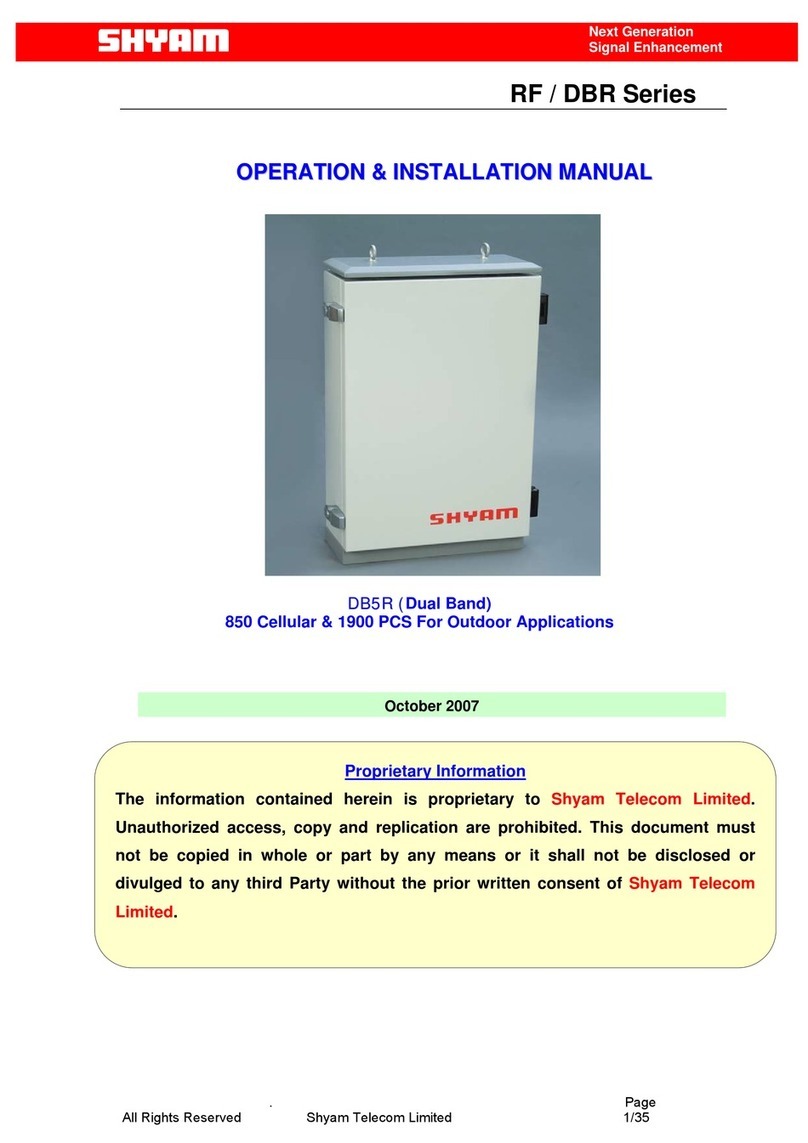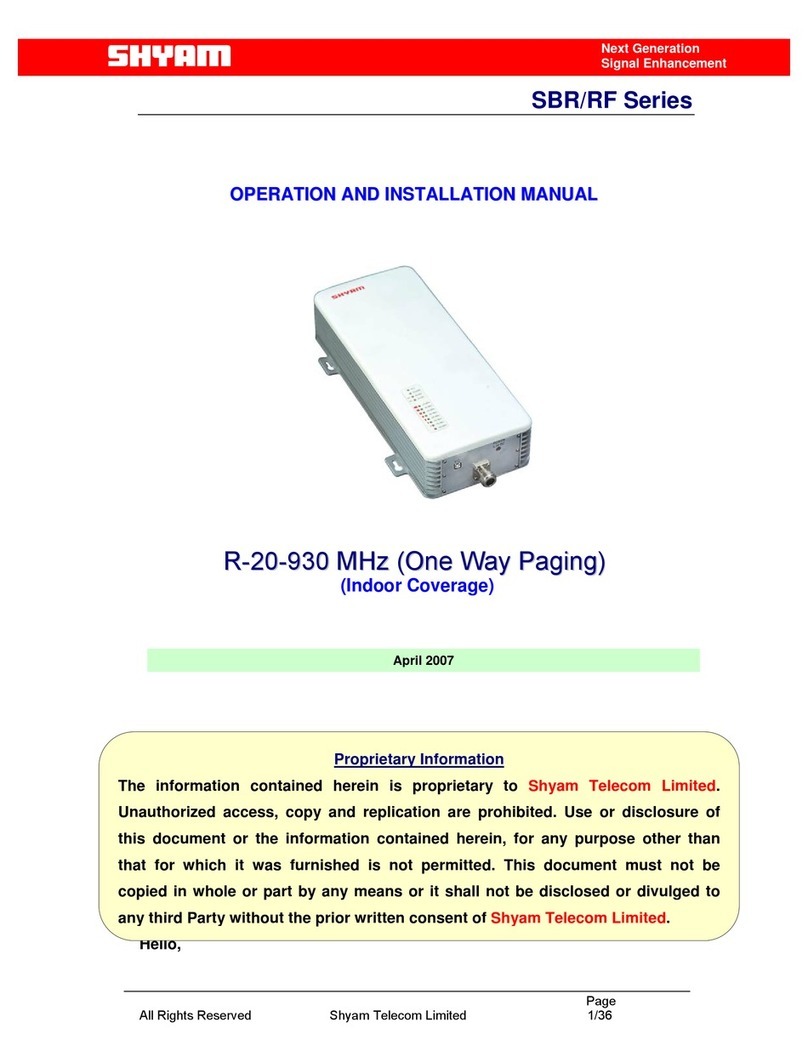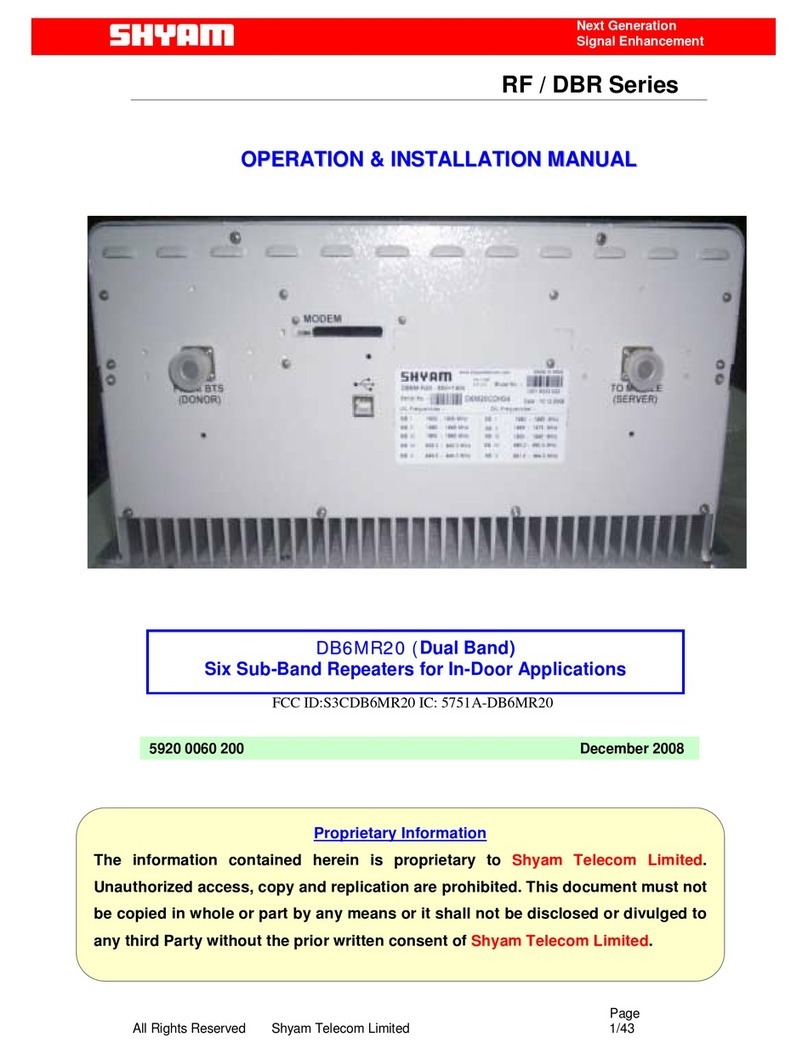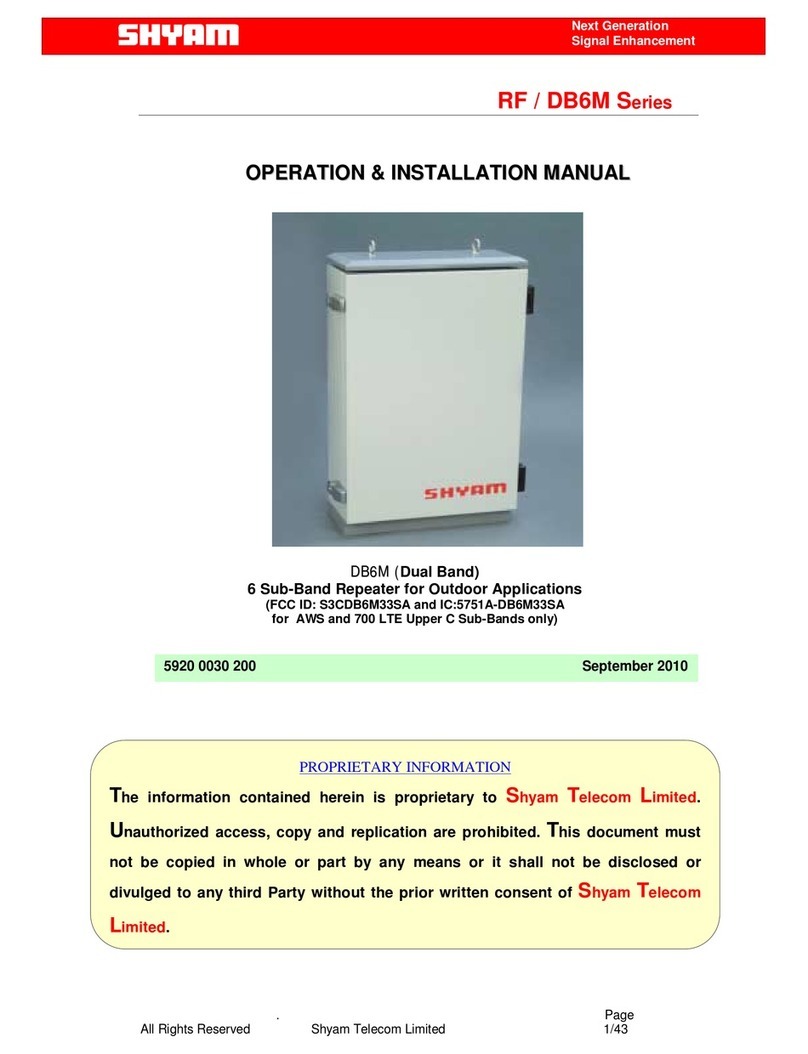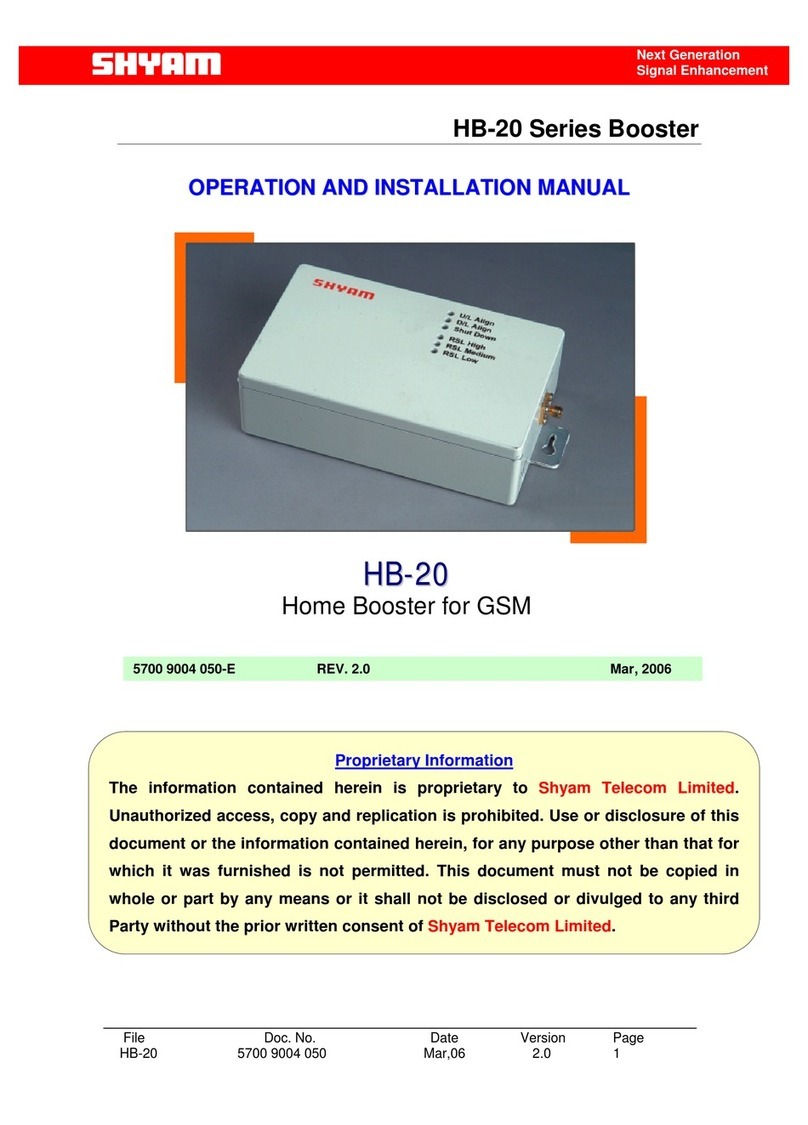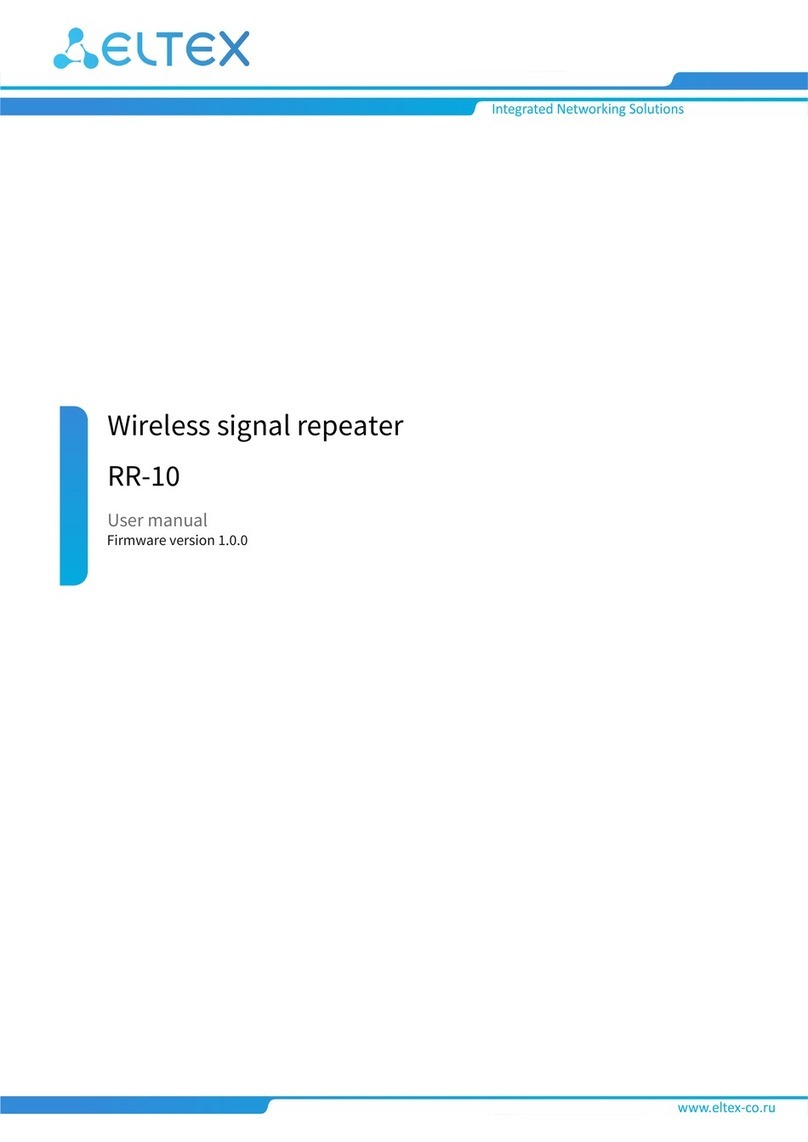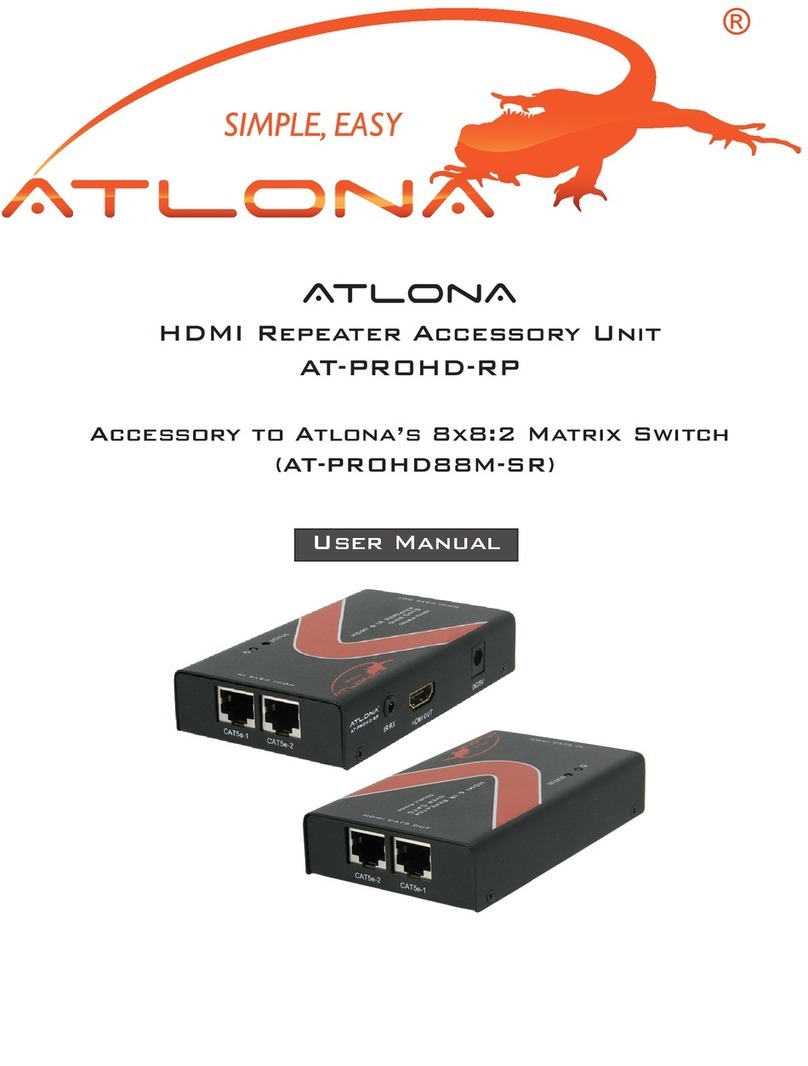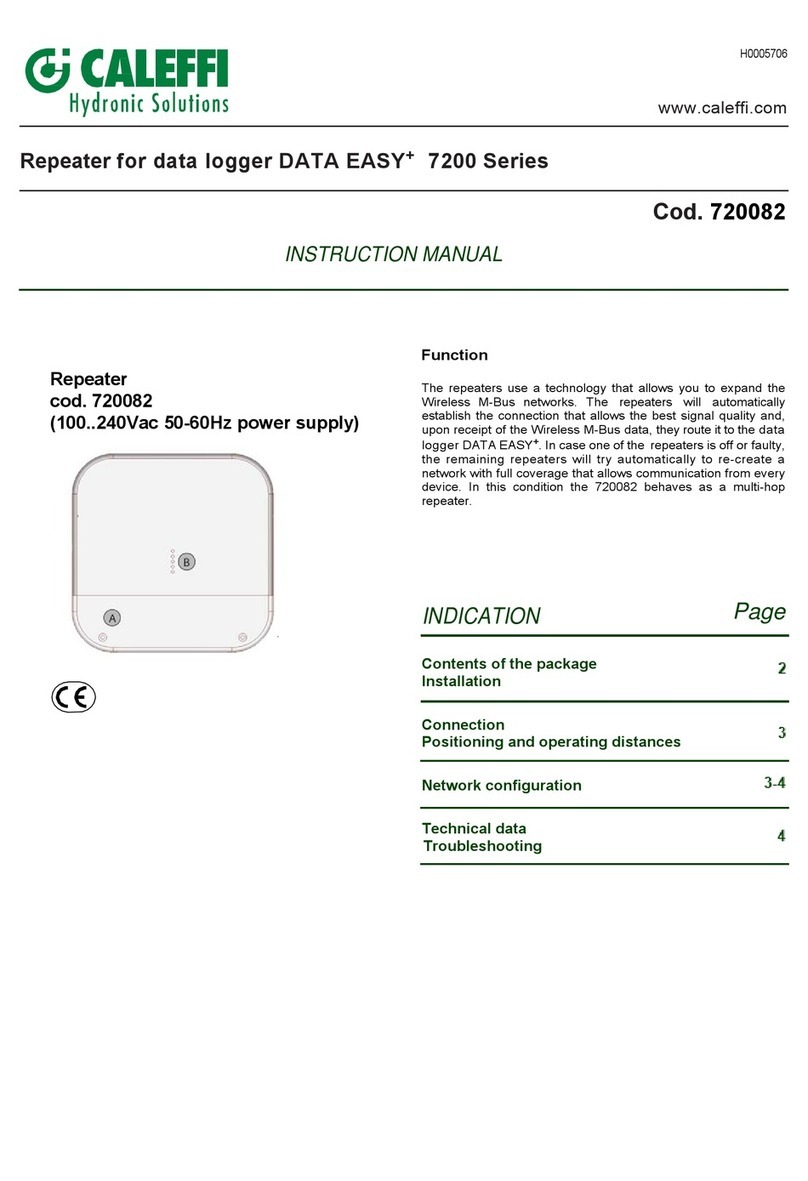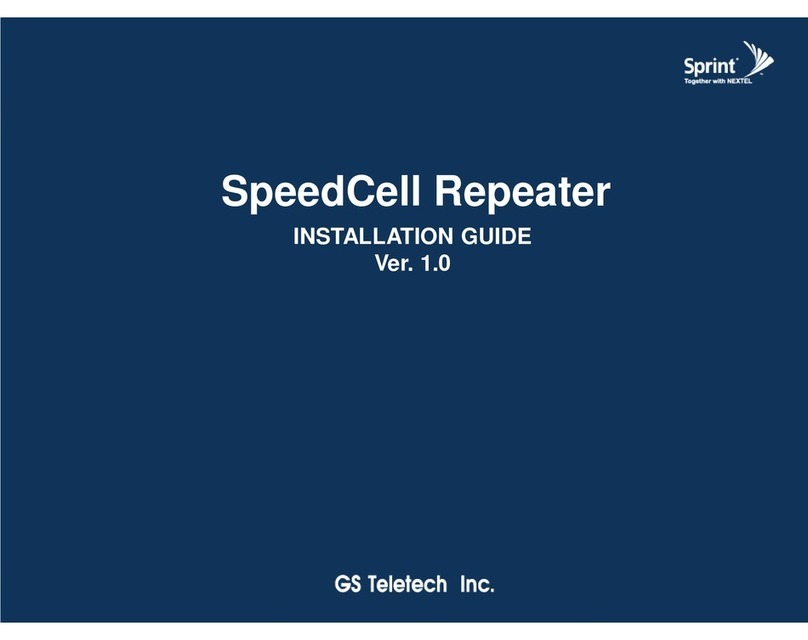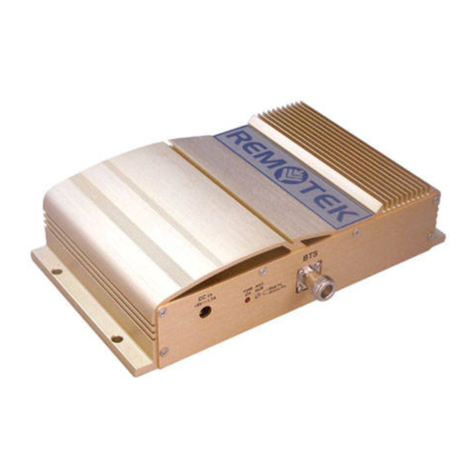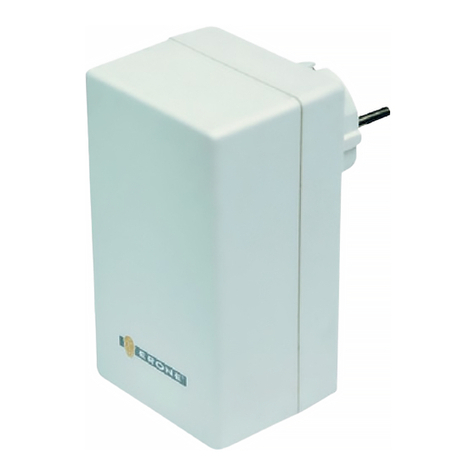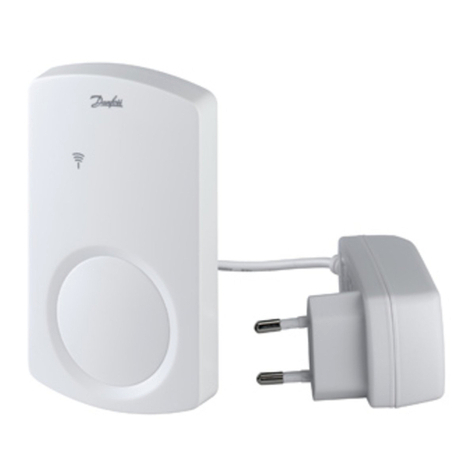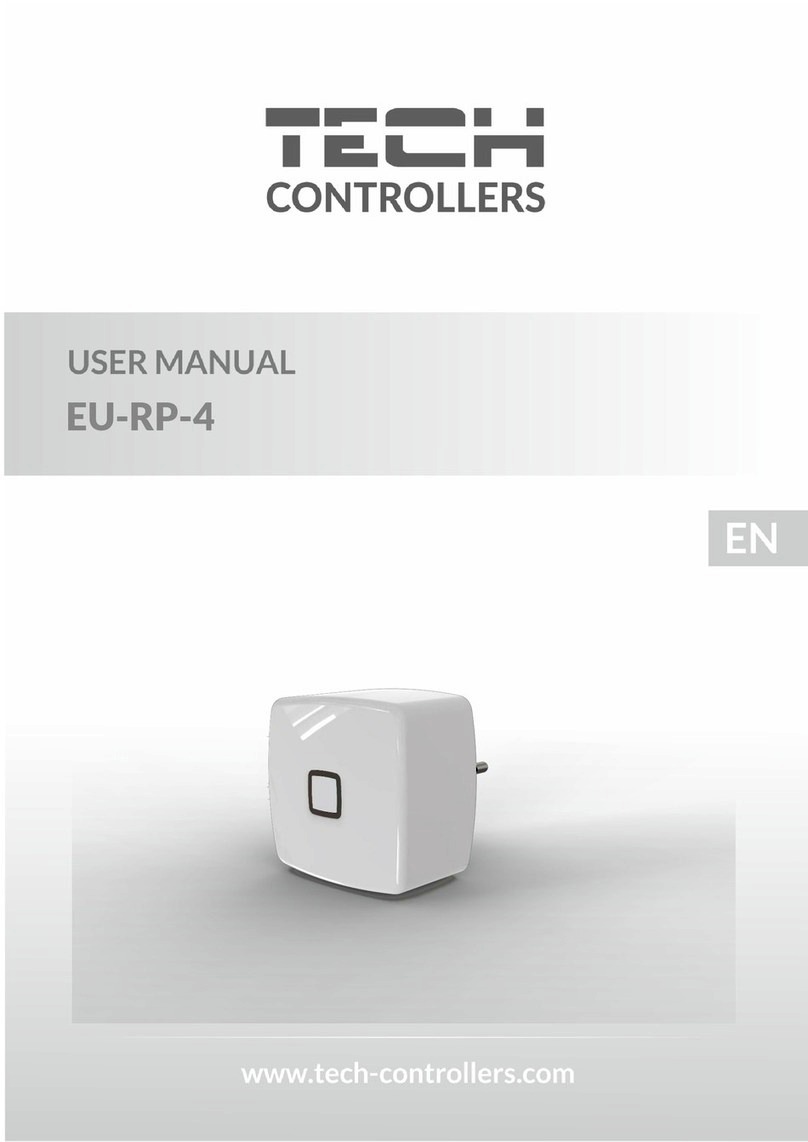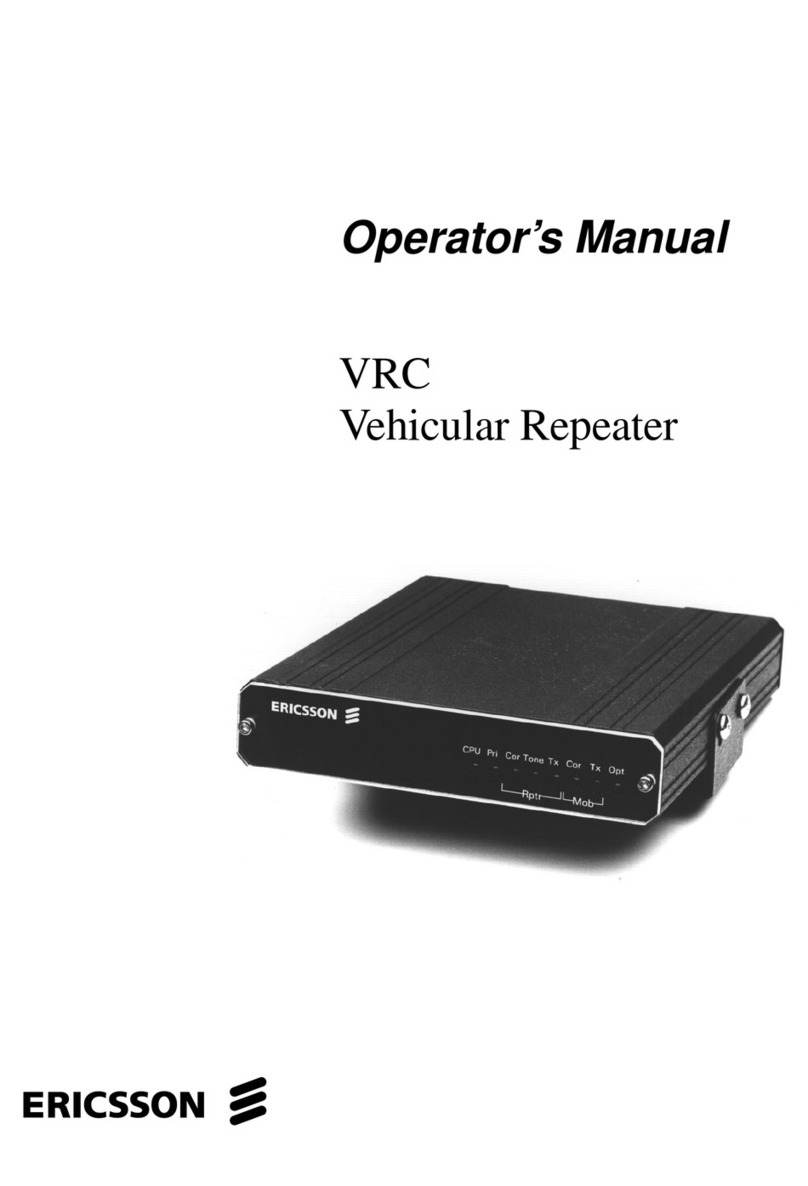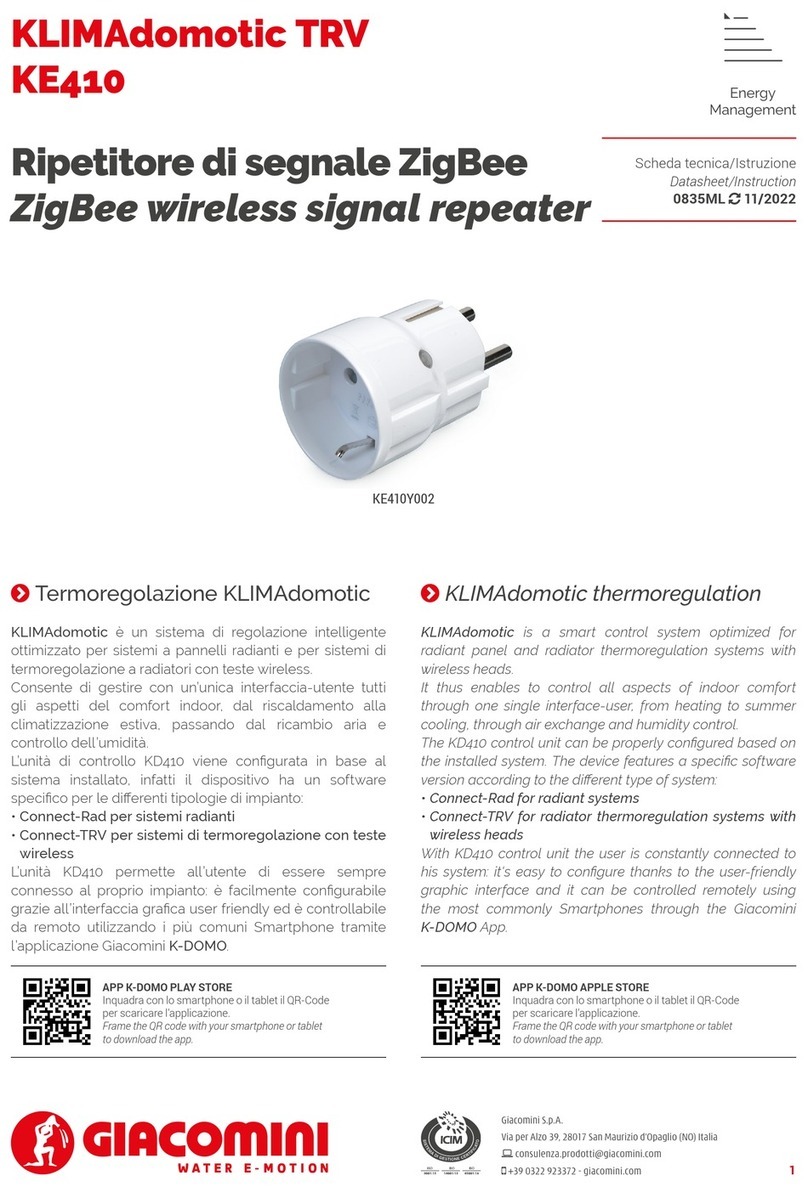Shyam RF Series User manual

All Rights Reserved Shyam Telecom Limited Page
1/34
Next Generation
Signal Enhancement
RF / SBR Series
O
OP
PE
ER
RA
AT
TI
IO
ON
N
&
&
I
IN
NS
ST
TA
AL
LL
LA
AT
TI
IO
ON
N
M
MA
AN
NU
UA
AL
L
June 2007
RR44--3300--SSMMR800 ((BBaannddSSeelleeccttiivvee))RReeppeeaatteerr
Single Sub Band Repeater For Indoor Applications (FCC ID: S3CR4-30-S8)
Proprietary Information
The information contained herein is proprietary to Shyam Telecom Limited.
Unauthorized access, copy and replication are prohibited. This document must not
be copied in whole or part by any means or it shall not be disclosed or divulged to
any third Party without the prior written consent of Shyam Telecom Limited.

All Rights Reserved Shyam Telecom Limited Page
2/34
Next Generation
Signal Enhancement
Contents
1. Document History.......................................................................................... 3
2. Disclaimer ...................................................................................................... 3
3. Safety Instructions and Warnings................................................................ 3
3.1. Personnel Safety ............................................................................... 3
3.2. Equipment Safety .............................................................................. 3
3.3. Electrostatic Sensitivity ...................................................................... 4
4. Introduction.................................................................................................... 6
4.1. Purpose ............................................................................................. 6
4.2. Scope................................................................................................. 6
4.3. Definitions .......................................................................................... 6
4.4. References ........................................................................................ 7
4.5. General .............................................................................................. 7
5. Functional Description Of R4 Band Selective Repeater............................. 8
5.1. General Description ........................................................................... 8
6. To Get started-Basic Software Control Of the System............................. 11
6.1. General ............................................................................................ 11
6.2. Terminal Set-up ............................................................................... 11
6.3. Block Diagram Description..................
7. R4 Repeater Specifications ........................................................................ 21
7.1. Electrical Specifications-RF ............................................................. 21
7.2. Electrical Specification Power Requirement .................................... 21
7.3. External Electrical Interface ............................................................. 21
7.4. Mechanical Specification ................................................................. 21
7.5. Environmental Specification............................................................. 22
7.6. Contents of Delivery......................................................................... 22
8.Installation..................................................................................................... 23
8.1. Preparation Sheet- Pre Installation .................................................. 23
8.2. Engineering Consideration............................................................... 24
8.3. Installation Tools .............................................................................. 26
8.4. Installation Procedure ...................................................................... 26
8.5. Gain Setting ..................................................................................... 27
8.6. Commissioning System ................................................................... 28
8.7. Dos & Don’t Dos .............................................................................. 28
8.8. Checklist – Post Installation ............................................................. 29
9. System Maintenance................................................................................... 30
9.1. General ............................................................................................ 30
9.2. Preventative Maintenance ............................................................... 30
9.3. In-Building Coverage Problems ....................................................... 30

All Rights Reserved Shyam Telecom Limited Page
3/34
Next Generation
Signal Enhancement
1. Document History
Document
Number Document
Name Document
date Author Edited
by Approved by Revision
R4 Band
Selective
Repeater
June
2007
Revision Revised Section Date/Sign
2. Disclaimer
Every attempt has been made to make this material complete, accurate, and
up-to-date. Users are cautioned, however, that Shyam Telecom Limited
reserves the right to make changes without notice and shall not be
responsible for any damages including consequential, caused by reliance of
the contents presented, including, but not limited to, typographical,
arithmetical, or listing errors.
Product name(s) referenced in this document may be trademarks or
registered trademarks of their respective companies, and are hereby
acknowledged.
In areas with unstable power grids (mains) all repeaters must be installed
with a voltage regulator ensuring a constant voltage level at the repeater
power input. A maximum voltage deviation should remain within the input
range to the repeaters for warranty purposes.
All antennas must be installed with lighting protection. Damage to internal
modules, as a result of lightning is not covered by the warranty.
3. Safety Instructions and Warnings
3.1. Personnel Safety
Before installing or replacing any equipment, the entire manual should be
read and understood. The user needs to supply the appropriate AC power to
the Repeater. Incorrect AC power settings can damage the repeater and
may cause injury to the user.
Throughout this manual, there are "Caution" warnings, "Caution" calls
attention to a procedure or practice, which, if ignored, may result in injury or
damage to the system or system component or even the user. Do not
perform any procedure preceded by a "Caution" until the described
conditions are fully understood and met.
3.2. Equipment Safety
When installing, replacing or using this product, observe all safety
precautions during handling and operation. Failure to comply with the
following general safety precautions and with specific precautions described
elsewhere in this manual violates the safety standards of the design,
manufacture, and intended use of this product. Shyam Telecom Limited
assumes no liability for the customer's failure to comply with these
precautions. This entire manual should be read and understood before
operating or maintaining the repeater system.

All Rights Reserved Shyam Telecom Limited Page
4/34
Next Generation
Signal Enhancement
CAUTION
Calls attention to a procedure or practice which, if not followed, may result
in personal injury, damage to the system or damage to individual
components. Do not perform any procedure preceded by a
CAUTION until described conditions are fully understood and met.
WARNING! This equipment complies with FCC & IC radiation exposure limits
set forth for an uncontrolled environment. This transmitter must not be co-
located or operating in conjunction with any other antenna or transmitter.
The unitwith server antenna must be installed to provide minimum 40 cm
separation distance between the server antenna and the body of user or
near by person. The donor antenna used for this transmitter must be fixed-
mounted on outdoor permanent structures with a separation distance of at
least 1.5 meters from all persons during normal operation.
The RF electric performance of the repeater conforms to FCC requirement of
the inter modulation and spurious emission. It avoids interference problems.
3.3. Electrostatic Sensitivity
CAUTION
ESD = ELECTROSTATIC DISCHARGE SENSITIVE DEVICE
Observe electrostatic precautionary procedures.
Semiconductor transmitters and receivers provide highly reliable
performance when operated in conformity with the intentions of their design.
However, a semiconductor may be damaged by an electrostatic charge
inadvertently imposed by careless handling.
Static electricity can be conducted to the semiconductor chip from the centre
pin of the RF input connector, and through the AC connector pins. When

All Rights Reserved Shyam Telecom Limited Page
5/34
Next Generation
Signal Enhancement
unpacking and otherwise handling the Repeater, follow ESD precautionary
procedures including the use of grounded wrist straps, grounded workbench
surfaces, and grounded floor mats.

All Rights Reserved Shyam Telecom Limited Page
6/34
Next Generation
Signal Enhancement
4. Introduction
4.1. Purpose
The purpose of this document is to describe the electrical and mechanical
specifications, operation and maintenance of the R4 Band Selective
Repeater.
4.2. Scope
This document is the product description of the Shyam R4 Band Selective
Repeater for Indoor applications.
4.3. Definitions
AGC Automatic Gain Control
ALC Automatic Level Control
APC Automatic Power Control
BCCH Broadcast Control Channel
BTS Base Transceiver Station
BSEL Band Selective
CDMA Coded Division Multiple Access
CMC Configuration & Monitoring Console software
CMB Combiner Unit
CSEL Channel Selective
DCS Digital Communication System
DL Downlink signal (from base station via repeater to
mobile station)
EGSM Extended Global System for Mobile Communication
ETSI European Telecommunications Standard Institute
GSM Global System for Mobile communication
LAC Location Area Code of the BTS site
LED Light Emitting Diode
LNA Low Noise Amplifier
LO Local Oscillator
MS Mobile Station
MSC Mobile Switching Center
NMS Network Management System
PCN Personal Communication Network
PCS Personal Communication System
PSU Power Supply Unit
RF Radio Frequency
RMS Remote Management System
RSSI Received Signal Strength Indication
RTC Real Time Clock
UL (Uplink) Uplink signal direction (from mobile station via
repeater to base station)

All Rights Reserved Shyam Telecom Limited Page
7/34
Next Generation
Signal Enhancement
4.4. References
[1] ETS 300 086.
[2] ETS 300 609-4.
[3] ETS 300 342-3
4.5. General
Mobile Communications Systems are planned as cellular systems and each
cell of the base station is required to provide RF coverage over a certain
geographical area as per defined RF power levels. Due to the RF
propagation properties, even using high radiated RF powers or complicated
antenna systems, there are zones within the coverage area where the RF
signal strength from base station remains inadequate for establishing the
desired connectivity to mobile users.
Repeaters traditionally are deployed in the Mobile Communication Network
to fill in the “Dead Zones” caused by blocking of signals by geographic
topologies such as mountains, valleys, dense foliage, high rising urban
landscapes and other man-made structures. The distance from the base
station also adversely affects the RF signal strength. The user views
repeaters as a means to extend base station coverage so as to reduce the
number of base stations and thereby accelerate network availability.
Repeater systems are installed after meticulous planning between BTSs and
the mobile users to provide RF coverage in the shadowed regions. Repeater
systems are available for different applications and ultimate choice shall
depend on some of the factors mentioned below:
•Area to be provided with coverage.
•Indoor/outdoor coverage.
•Availability of BTSs in the vicinity.
•Antenna isolation to be achieved.
Radio Equipment and Systems Land mobile service Technical
characteristics and test conditions for radio equipment with an internal or
external RF connector intended primarily for analogue speech.
Digital cellular telecommunications system (phase 2): Base Station
Systems (BSS) equipment specification: Part 4: Repeaters.
Radio Equipment and Systems (RES); Electro-Magnetic Compatibility
(EMC) for European Digital Cellular Telecommunications systems. Base
Station Radio and ancillary equipment and Repeaters meeting phase 2
GSM requirements.

All Rights Reserved Shyam Telecom Limited Page
8/34
Next Generation
Signal Enhancement
5. Functional Description Of R4 Band Selective Repeater
5.1. General Description
The R4 Band Selective Repeater System is designed to provide indoor
coverage and can handle signals in single sub band in any one of the service
bands, used around the World by various service operators. It provides
highly selective amplification in the pre-set band. The details of operating
service frequency bands are given below:
S.NO. Service Band DL Frequency (MHz) UL Frequency (MHz)
1. SMR 800 851-869806-824
2. Cellular 869-894 824-849
3. SMR 900 935-941 896-902
4. EGSM 925-960 880-915
5. GSM 900 935-960 890-915
6. DCS 1805-1880 1710-1785
7. PCS 1930-1990 1850-1910
8. UMTS 2110-2170 1920-1980
[The Customer is advised to refer to the packing note giving the details of
frequency band set & the bandwidths of different sub bands equipped in the
repeater: Only SMR800 Band is subject to this FCC Application w/ FCC ID: S3CR4-30-S8]
•The repeater adoptsduplex mode and bi-directional amplification for
U/L & D/L signals between the base station and mobile users. It has
been designed for outdoor applications to meet the requirements of
large number of users in the targeted area.
•It conforms to ETSI standards & safety requirements.
•The system can be incorporated with optional Remote Management
System (RMS). It enables status monitoring, remote configuration &
speedy maintenance.
•The system can be customized to meet the requirement of user for
coverage by making provision for radiating required RF power in the
DL/UL paths to achieve the coverage. The System is incorporated
with monitoring facility through USB port with easy GUI interface.
•It intercepts signals from the BTS through a DONOR antenna (highly
directional outdoor antenna) and distributes the signals to mobile
users after amplification through SERVER antennas (omni
directional) system in the D/L.
•In the U/L, the signals from the mobile users are picked up by
SERVER antenna and retransmitted to the BTS after processing &
amplification in the repeater.

All Rights Reserved Shyam Telecom Limited Page
9/34
Next Generation
Signal Enhancement
The repeater consists of the following modules/units:
•LNA
•Converter modules
•Power amplifiers
•Power supply modules
•Duplexer filters for transmit/receive directions
•Supervisory module
•A metallic case houses the repeater. Arrangement is made for heat
dissipation especially for amplifiers, which generate more heat. The
choice of suitable metal as the case material gives a lightweight
design with good heat conduction. The housing is not waterproof
since it is to be used for indoor application.
Figure 1: Indoor Coverage (Typical Application)
Ceiling
Antenna
R4 Unit

All Rights Reserved Shyam Telecom Limited Page
10/34
Next Generation
Signal Enhancement
Figure 2: Indoor Coverage In a Office Premises
Ceiling
Antenna
R4-30-
SMR800

All Rights Reserved Shyam Telecom Limited Page
11/34
Next Generation
Signal Enhancement
6. To Get started-Basic Software Control Of the System
6.1. General
The system is equipped with a supervisory module that allows the monitoring
and control of various parameters such as RF power, attenuation,
temperature, status of door and alarm conditions etc.
The communication interface between the local terminal and the control
module can be set up using the Configuration & Monitoring Console software
(CMC), which is an easy to use GUI for simple control and monitoring. This
way, the parameters can be easily observed and adjusted from the display
terminal.
This can be performed either via a terminal (PC/laptop) locally, or via remote
login through the wireless modem (Optional) located in the repeater. USB
port is provisioned in the equipment for connecting PC/laptop.
6.2. Terminal Set-up
The system is delivered with software loaded in order to perform
configuration as per requirement. It also enables monitoring the status.
Configuration of parameters can be carried out locally with the help of laptop
/ PC connected to the repeater by means of local USB serial interface or
remotely via wireless modem (Optional) mounted inside the repeater. The
laptop/PC should be loaded with the CMC software available on the supplied
CD along with the USB driver.
I) LOGIN Repeater
After running the Configuration & Monitoring Console (CMC), user needs
to login the repeater, sequence as under, may be followed:
•Click the “LOGIN” on the command bar.
•Select the user type (ADMINSTRATOR or SUPERVISOR).
•Enter the password.
•Finally click the “OK”.
A message “Logged in successfully” will appear on the screen after
successful login. There are two types of users viz. ADMINISTRATOR and
SUPERVISOR. If user logged in as an ADMINISTRATOR, all the
functions can be performed through the CMC. By default, the password
for both users is “SHYAM”.
SUPERVISOR is allowed to perform monitoring of the status & alarms but
no change in configuration is permitted. However, the SUPERVISOR can
change password if so desired.

All Rights Reserved Shyam Telecom Limited Page
12/34
Next Generation
Signal Enhancement
Figure 3: Login Repeater
II) CONFIGURATION (Figure 4)
Configuring system means setting the parameters for operation as per the
requirement at site. The configuration is carried out after the physical
installation is completed.
Click on the command bar to display the configuration and monitoring
window, which allows access to all the configurable repeater parameters.
User can login for configuration & monitoring of repeater parameters.
•START command is for initiating the dialogue.
•SET command is for updating the repeater parameters.
Information as detailed below, is configured after the “CONFIGURATION”
window is activated:
i. Repeater ID: User can assign a unique repeater ID to each repeater
installed. Up to 10 characters are allowed in this field.
ii. Repeater Location: User can assign the address of location where
repeater is installed. Up to 30 characters are allowed in this field.
iii. Sub Bands (UL/DL Frequency Bands): The frequency bandwidth
with frequency details, of the loaded sub band in UL & DL paths are
specified.

All Rights Reserved Shyam Telecom Limited Page
13/34
Next Generation
Signal Enhancement
iv. Output Power: Maximum Output Power limits in UL & DL paths are
set. A “PA Power high” alarm will be generated when PA power
exceeds the upper limit.
Figure 4: Configuration Window
v. RSSI Alarm (Down Link): Lower and Upper RSSI Limits in DL are set
in the factory. A RSSI High alarm will be generated when RSSI
exceeds the set upper limit, and a RSSI Low alarm will be generated
when RSSI goes below the set lower limit. Upper range can be set
from -35 to -55dBm. Lower range can be set from -75 to -95dBm
vi. PA On/Off: User can set uplink and/or downlink PA as ON or OFF
independently for testing/maintenance purpose at the time of
installation for both the bands.
After completing the installation it must be in ON condition only.
vii. Attenuation: This field is specified with the attenuation inserted in the
system, both in the DL & UL directions to set the desired RF power.
viii. Save Parameters as Text File:
SAVE: Configured parameters can be saved as text file by
clicking at SAVE for later reference.
ix. Open Text File:
OPEN: Saved configured text file can be opened and
displayed on the configuration window by clicking at
OPEN.

All Rights Reserved Shyam Telecom Limited Page
14/34
Next Generation
Signal Enhancement
Figure 5: Monitoring/Alarm Window
III) MONITORING (Figure 5)
In this window, the status of the system is monitored for the following
parameters/conditions:
STATUS
S.NO. Parameters/Conditions Remarks
1. Start and Stop Frequency of
sub band, equipped.
The specified frequency bands in
DL & UL are displayed.
2. RSSI (DL) for the Band
Real time DL signal level is
indicated.
3. RSSI (UL) for the Band
Real time UL signal level is
indicated.
4. Attenuation DL
Indicates attenuation inserted in
the system in DL path.
5. Attenuation UL
Indicates attenuation inserted in
the system in UL path.
6. Output Power DL RF output power in DL path is
displayed.

All Rights Reserved Shyam Telecom Limited Page
15/34
Next Generation
Signal Enhancement
7. Output Power UL RF output power in UL path is
displayed.
8. PA Temperature DL
Real time value of temperature of
PA in DL path.
9. PA Temperature UL
Real time value of temperature of
PA in UL path.
10. APC (DL) The APC action in the DL path is
indicated.
11. APC (UL) The APC action in the UL path is
indicated.
12. System Temperature Real time system temperature is
indicated.
13. Power supply Values of derived voltages are
displayed,
IV) ALARMS (Figure 5)
Details of alarms displayed are given below:
S.NO. Alarm Indication Remarks
1. PA OFF (Manual) The alarm indicates the PA OFF
(Manual) condition in the DL &/or UL
paths.
2. PA OFF (Auto) The alarm indicates the PA OFF
(Auto) condition in the DL &/or UL
paths.
3. PA Power Low DL When PA Power in DL path goes
below the set limit, is indicated
through the alarm.
4. PA Power High DL When PA Power in DL path exceeds
the upper limit, is indicated through
the alarm.
5. DL PA Temperature High When PA Temperature in DL path
exceeds limit, alarm is generated.
6. UL PA Temperature High When PA Temperature in UL path
exceeds limit, alarm is generated.
7. LNA Alarm The alarm indicates the failure of LNA
in DL/UL paths.
8. VSWR Alarm The alarm indicates the mismatch
condition at the DL/UL RF ports
resulting in exceeding the VSWR
limits (1.5:1).
9. Synthesizer fail for the
sub band. The failure of relevant synthesizer in
DL/UL direction is indicated through
the alarm.
10. RSSI low (DL) The alarm indicates that the RSSI
strength has gone lower than the set
limit in the DL direction.
11. RSSI high (DL) The alarm indicates that the set upper
limit of RSSI in the DL direction has
exceeded.
12. AC fail Indicates the failure of AC mains to
the system.

All Rights Reserved Shyam Telecom Limited Page
16/34
Next Generation
Signal Enhancement
13. DC fail Indicates the failure of DC derived
voltages in the system.
14. System Temperature Indicates the rise in temperature of
the system.
15. Door Open Indicates the opening of the door of
the repeater.
Monitoring interval is 3 seconds i.e. after every 3 seconds data on the
monitoring window is refreshed.
A red indication is for Alarm present.
A green indication is for No alarm.
V) Establishing Communication (Figure 6)
The system has provision of establishing communication on “LOCAL” &
“Remote” basis. In COMMUNICATION window, user can select serial
communication port of the computer and type of connection between
repeater and computer.
a. LOCAL CONNECTION
In this type of connection, user computer COM Port and repeater’s
USB port are connected directly using cable. Sequence is as under:
•Click the “COMM.” on the command bar to display the
COMMUNICATION window.
•Select the Connection Type as “LOCAL”
•Select the computer’s Comm. Port where the repeater is
connected.
•Click “OK”.
b. REMOTE CONNECTION
In this type of connection, User communicates from/to remote location
with the repeater using wireless Modem / Cell phone.
To connect:
•Click the “COMM.” on the command bar to display the
COMMUNICATION window.
•Select the Connection Type as “REMOTE”.
•Select the computer’s Comm. Port where the wireless Modem
is connected.
•Click “OK”.
•Now click the DIALUP on the command bar to display the
DIALUP window.
•Enter / Select the repeater phone number.
•Click the “DIAL” and wait (maximum 60 seconds) for
connection.
A message “CONNECTED” will appear on the screen after the GSM
Connection is established.
Click the “DISCONNECT” on the DIALUP window to
disconnect remote communication with the repeater.

All Rights Reserved Shyam Telecom Limited Page
17/34
Next Generation
Signal Enhancement
Figure 6: Communication Window
VI) Instant Alarms by SMS (Figure 7)
The provision exists in the system for getting the alarm information
through “Instant Alarms by SMS” which is carried out by Wireless
Modem. Following information is desired to be fed for enabling this
facility:
•SMS Service Center Number
•RMS Phone Number
•Maintenance Phone Number
VII) Security Settings (Figure 8)
The system has two levels of permitting Log in to the repeater to avoid
unauthorized operation. The levels are: ADMINISTRATOR &
SUPERVISOR.
Each level has a specific password. The password for each level can be
changed at intervals. ADMINISTRATOR has rights to perform all
functions Viz. Configuration, Monitoring etc. Whereas the SUPERVISOR
is allowed to perform limited functions like monitoring of alarms,
establishing communication etc.

All Rights Reserved Shyam Telecom Limited Page
18/34
Next Generation
Signal Enhancement
Figure 7: Instant Alarms by SMS
Figure 8: Security Settings

All Rights Reserved Shyam Telecom Limited Page
19/34
Next Generation
Signal Enhancement
a. DONOR Antenna
Donor antenna of appropriate bandwidth & gain interfaces the BTS on
one side and repeater system on other side through RF cable.
Figure 10: Donor Antenna (Patch Panel)
It receives signals from the base station and transforms electromagnetic
waves into RF signals in the DL and vice versa in the UL. The antenna
with more than 10-12 dB gain transfers received signals to the repeater
and transmits uplink signals amplified by the repeater.
b. Duplexer
The main function of duplexer is to isolate the uplink frequency from the
downlink frequency, i.e. isolate transmit path from receive path. Two
duplexer units are provided in the repeater, one in the Donor antenna
side and other in the server antenna side. Each duplexer
transfers/receives signals from respective antenna for further connectivity
to low noise amplifier. The bandwidth of the duplex filter depends on the
operator’s frequency band (25MHz, 15MHz, 10MHz, 9MHz, or full
Band etc.).
c. Low Noise Amplifier (LNA)
This module is provided after duplexer before the converter. The LNA
provides compensation for the losses suffered by the stream of weak
signals as it passes through splitter/combiner & duplexer (passive
devices). Two LNAs are provided, one each in the UL & DL directions.
d. Converter Module
The basic block of converter module comprises of L.O., frequency mixer,
filter and intermediate amplifier. The low noise amplified signals are
converted to IF in frequency mixer with frequency fed from LO. The

All Rights Reserved Shyam Telecom Limited Page
20/34
Next Generation
Signal Enhancement
signals are passed through sharply tuned filters. Two converters, one in
DL path & other in the UL path are equipped.
e. Power Amplifier
It is the core module of repeater. It includes driver stage and final stage. It
is installed directly on the heat sink of the repeater. Driver stage and final
stage of power amplifier are in the same unit. Two power amplifiers with
specific frequency bandwidths & gain are provided, one each in the UL &
DL directions.
f. Controller Module (Supervisory)
The man-machine communication between the cellular operator and the
repeater is established through this module. One of the two options as
given below can be used for achieving this objective:
•USB interface
•Wireless modem (Optional)
Remote controlling function of repeater can be achieved by inserting
Wireless modem. This arrangement also enables status of repeaters at
different locations to be monitored.
g. POWER SUPPLY
The power supply unit incorporated in the repeater is of high efficiency
and reliability. Different DC voltages required for the operation of
electronic circuitries are derived in this unit. The standard input voltage is
100 to 240 V AC, 47 Hz to 63 Hz. When the power supply varies in this
range and the frequency in 47 to 63Hz, its output DC derived voltages
remain constant within 1% of nominal value.
h. SERVER Antenna
Server antenna transmits signals from the repeater station to mobile
users and transport received uplink signals from the mobile users to the
base station. Based on the coverage area, a set of select panel
antennas with suitable gains & N type connecters is installed at pre-
planned spots.
Other manuals for RF Series
1
This manual suits for next models
2
Table of contents
Other Shyam Repeater manuals
Popular Repeater manuals by other brands
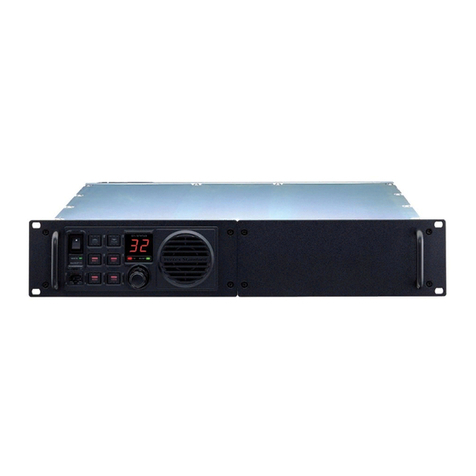
Vertex Standard
Vertex Standard VXR-9000 Series Service manual
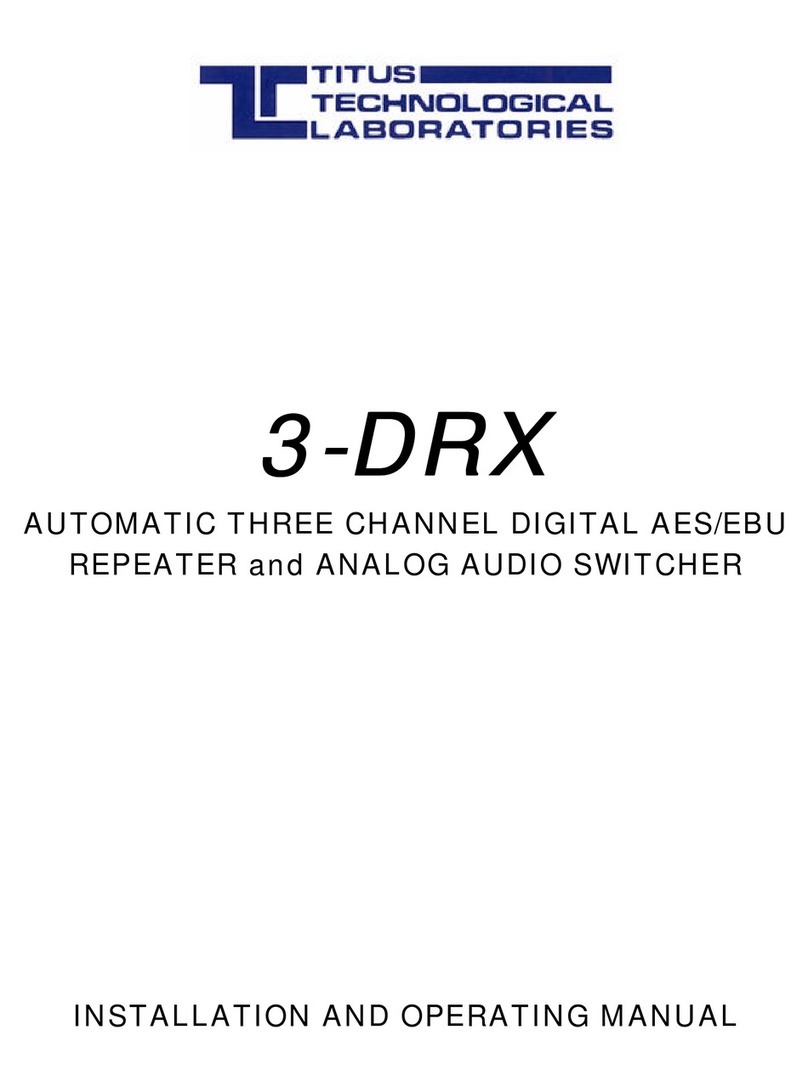
Titus
Titus 3-DRX Installation and operating manual
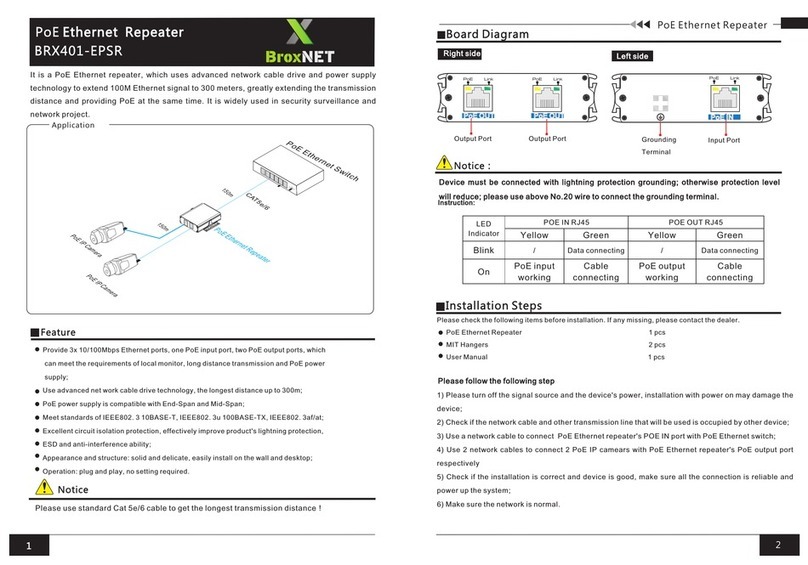
BroxNET
BroxNET BRX401-EPSR manual
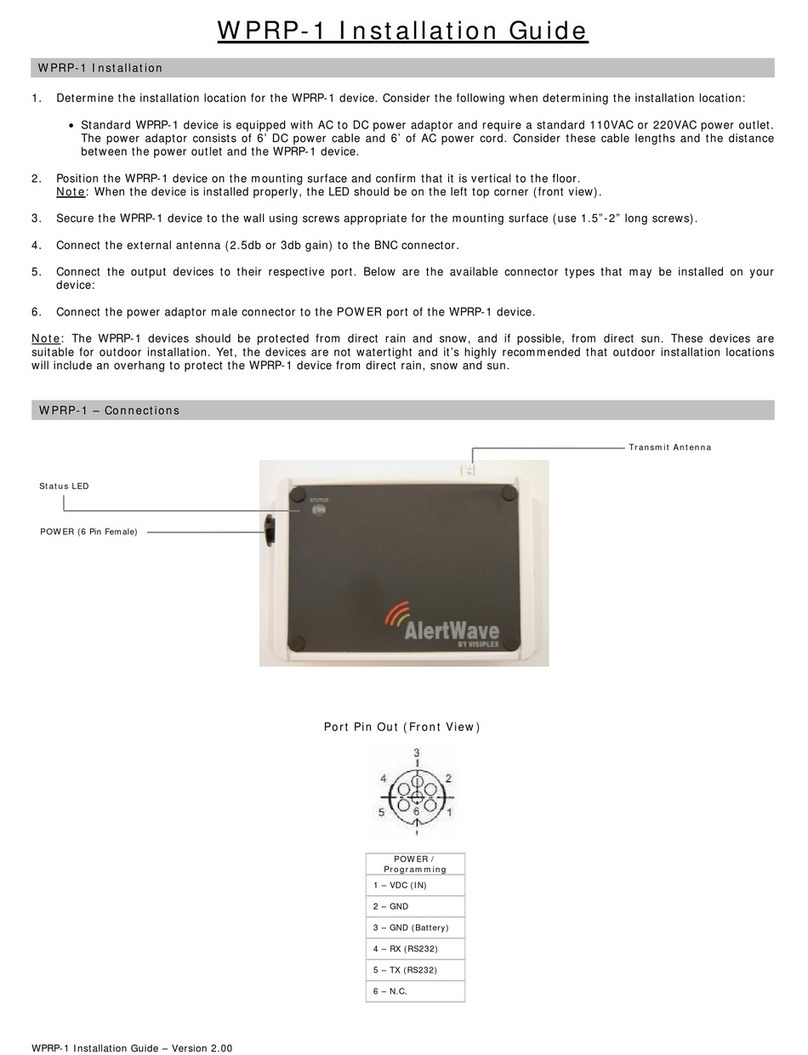
visiplex
visiplex AlertWave WPRP-1 installation guide
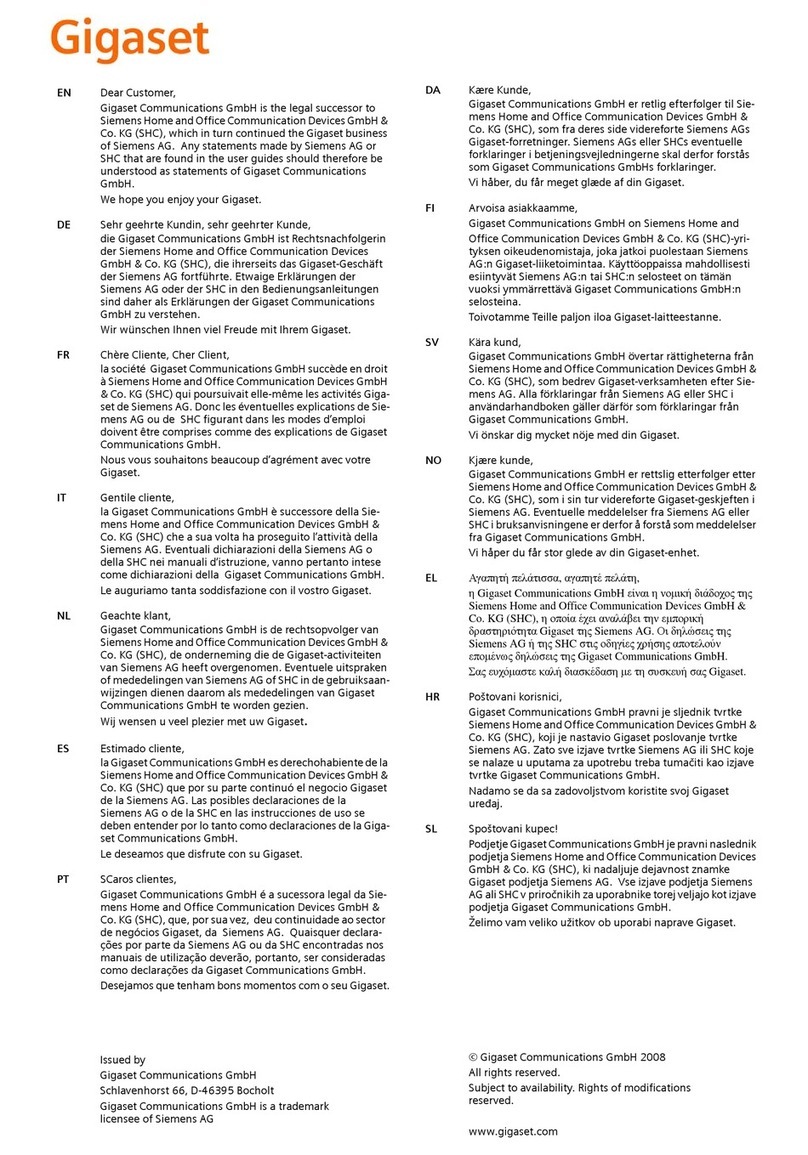
Siemens
Siemens Gigaset WLAN operating instructions
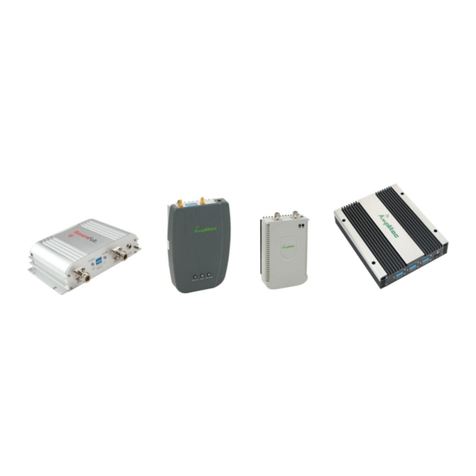
GSM-Repeater
GSM-Repeater C20/24/27C ED instruction manual
